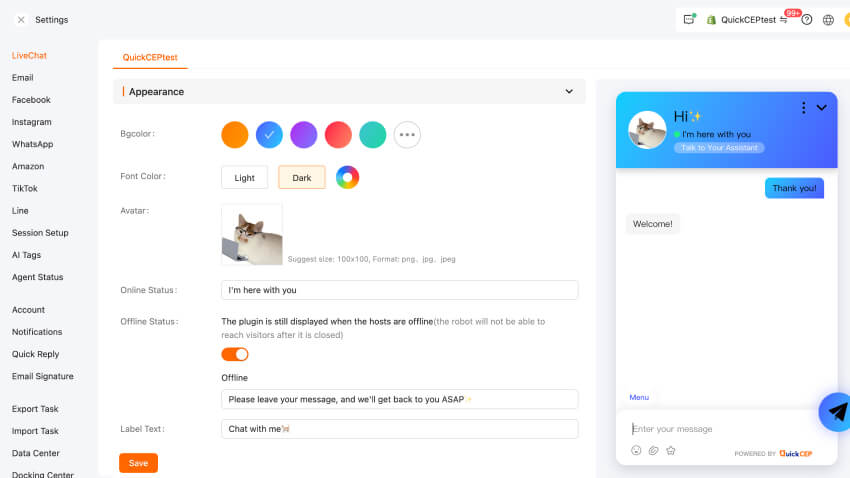What Is An AI Shopping Assistant?
An AI shopping assistant is a virtual guide for online shopping. It studies customer info—like what they bought before, what they’ve looked at, and what they like—to give personalized suggestions and tips.

Types of Shopping Assistants
There are many types of AI shopping assistants, each catering to different needs and platforms. Some of them are the following:
- Chatbots: Text- or voice-powered virtual assistants on websites or apps that can answer questions, recommend products, and guide customers through checkout.
- Mobile apps: AI-powered shopping companions on phones that suggest products, offer deals and let users scan barcodes for more info.
- Browser plugins: Discreet helpers for web browsers that help customers compare prices and highlight relevant items.
- Popups: Smart website windows that suggest products, personalize discounts, or remind customers about their cart.
How Do AI Shopping Assistants Work?
AI shopping assistants use machine learning algorithms, data analytics, and natural language processing (NLP) to study interactions with customers and learn their interests and behaviors. This way, they can refine their suggestions over time and adapt to changing trends and tastes.
Ultimately, various technologies allow AI shopping assistants to turn complicated shopping sessions into simple experiences.
Benefits of AI Shopping Assistants

There’s more to AI-based shopping than suggesting what shoppers might like. Here are the benefits you and your customers can enjoy.
Better Engagement
Gone are the days of browsing through a vast online catalog. AI assistants use past choices and interests to suggest products customers might want, making shopping more fun.
They can even answer questions about specific items or suggest alternatives that might better fit the customer’s needs. This personal touch keeps shoppers interested in finding just what they need.
Time-saving
AI assistants understand that time is precious in e-commerce. Studies show that up to 30-40% of shoppers spend 10-30 minutes on online shopping. Meanwhile, 89-96% of customers spend more than 10 minutes researching their purchases. You can shorten this time with AI shopping assistants.
Imagine asking a chatbot for “women’s running shoes with good arch support” and instantly seeing options that fit your request. This saves time and avoids searching through many irrelevant products.
Cost Reduction
While it requires an upfront investment, AI shopping assistants are still a cheaper option than live agents in the long run. As virtual shopping assistants automate customer interactions, they can help you save money and resources and improve your customer service without losing quality.
Plus, AI assistants are constantly available so customers always get support as needed.
Cross-selling
Traditionally, cross-selling and upselling tactics are often pushy. In contrast, AI shopping assistants do it more subtly and beneficially. By understanding a customer’s purchase history and preferences, they can recommend complementary products that enhance the overall purchase.
Let’s say you’re a tech brand and a customer decides to buy a new camera from your website. An AI shopping assistant can suggest compatible lenses or a carrying case to the customer before they check out. This approach feels less like a sales pitch and more like a helpful suggestion, potentially increasing your overall cart value.
Inventory Management
AI assistants can analyze customer behavior and purchase patterns, helping you optimize inventory levels. They can help reduce the chances of stockouts and ensure a wider selection of products are readily available for customers to choose from.
How AI Shopping Assistants Become Your Brand Ambassadors
AI shopping assistants are not just tools for enhancing the shopping experience; they can also represent your brand, shape consumer perceptions, and drive loyalty.

A 2024 study shows that AI-driven recommendation systems greatly influence what consumers buy. They help shoppers find products they might like, even ones they didn’t think about before. This makes shopping more fun and helps them discover new items.
Another research found that 91% of consumers are more likely to shop with brands that take note of their past interactions and send relevant offers. By promoting related products and offering valuable insights, AI shopping assistants foster a sense of trust and reliability among consumers, encouraging repeat purchases and positive word-of-mouth.
In short, AI shopping assistants make online shopping easier and help build a strong connection between you and your customers. They use data to improve engagement and satisfaction in ways that traditional marketing can’t. As you keep using AI, these assistants will change how you and customers interact in the digital age.
Key Considerations In Building AI Shopping Assistants
To have an effective AI shopping assistant, you need the right technological foundation. Take note of the following elements to maximize your investment.
Machine Learning Algorithms
The core of any AI shopping assistant is its machine learning algorithms. They analyze large amounts of data, such as product details, user behavior, and purchase history. By continually learning and adapting, they become good at predicting customer needs and suggesting relevant products.
Choosing the right algorithms is essential for building an assistant that is smart and intuitive.
Natural Language Processing
NLP makes AI shopping assistants into conversational partners. It helps them understand customer questions, requests, and conversation details. It even allows the assistant to understand vague questions and respond naturally, like a human. Advanced NLP makes interactions smooth and the shopping experience easy and hassle-free.
Data Collection and Analysis
Data fuels AI assistants. The more customer info you have, the better your assistant can recommend things just for them.
The key is finding a good balance. You need to collect enough data to make your suggestions accurate and personal, but you also have to respect your customers’ privacy. Being honest and clear about how you use their data helps them trust you more.
Chatbots
Chatbots provide the structure for real-time interaction and support to users. Luckily, platforms like QuickCEP make it easy to add a chatbot to your website. You can set up answers to common questions so you can quickly respond to basic queries. If a customer has a specific issue, the chatbot can quickly connect them with a live person for more personalized help.
Ultimately, QuickCEP can enhance customer service and guide your customers’ purchasing decisions better.
Integrated Conversational AI
Advanced conversational AI solutions give AI shopping assistants extra skills, such as sentiment analysis and context-aware responses. These abilities help them suggest relevant offerings and solve problems quickly, making customers happier and increasing sales.
QuickCEP offers this skill, helping you save time by responding to every customer seeking recommendations or specific support. What’s even better is its ability to respond in a human-like way, bridging the gap between technology and live assistance.
How To Integrate AI Shopping Assistants Into Your Website

2. Type your website’s address or choose the e-commerce platform hosted by your site. For instance, you can easily use QuickCEP to create a Shopify AI shopping assistant if your website runs on that platform.







